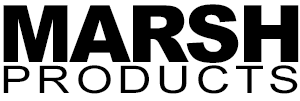Marsh Products’ Green Policy

At Marsh Products, we’re making a concerted effort to implement environmentally friendly practices and methods in our everyday operations. Not only is it the right thing to do—to reduce our carbon footprint, to help the environment and to keep our communities clean—but it also has reduced our operating costs, which helps the bottom line.
Implementing green policies has not been difficult, nor has it been an added burden. It simply makes sense from many different perspectives.
The following is a list of the policies and practices that we have implemented to date. We expect to add more in coming months.
Waste Reduction
- Separate garbage containers for the building are established for pickup; one for cardboard and paper recycling and the traditional container for garbage. The cost for pickup of the paper/cardboard recycling container is less than cost of the garbage container, reducing the company’s trash expense.
- Two trash bins are located at every desk and work area; one for garbage and the other a blue recycling bin for paper.
- All cardboard is recycled.
- All paper is recycled.
- All plastics (types 1 through 5) are recycled.
- All dead electronics are collected and taken to the local electronics recycling center.
- All employees are encouraged to print documents in duplex mode (on both sides of the paper).
- All employees are asked not to use Styrofoam containers, as Styrofoam is not recycled in our locality.
- All laser printer toner cartridges and inkjet cartridges are exchanged for remanufactured replacements.
- Only reusable cups/mugs are offered.
- A red worm composting bin has been set up in the lunchroom to compost food waste, coffee grounds, etc., reducing the waste produced.
- Packaging material from received goods is reused in shipping our products.
- When shipping products, the amount of packaging used is minimized in all possible ways, including the size of the box and the amount of necessary packaging material.
- Efforts are being made to purchase napkins and paper towels in unbleached form.
- All metal is taken to a metal recycling center. All proceeds from that recycling are put into a fund to implement larger environmental projects, such as photovoltaics for the roof of the building or on-demand hot water systems for the bathroom and lunchroom sinks. Such projects are in the planning stage.
- File folders are reused as much as possible.
- Purified water is supplied to all employees, encouraging them not to use water packaged in plastic bottles.
- Rain barrels are connected to gutters to water the building’s landscaping.
Energy Reduction
- All computers that do not need to run overnight are shut down.
- All monitors are turned off at the end of the workday.
- All computers are set to the best possible power-saving mode for based on each workstation situation.
- All fluorescent light fixtures are being replaced with the energy-efficient LED alternatives.
- Employees are educated to reduce energy usage whenever possible.
Toxin Reduction
- Environmentally friendly cleaning products are used. A great deal of research has gone into find products that work as well or better than the less eco-friendly alternatives.
- Whenever construction or remodeling is being performed, eco-friendly materials and supplies are sought out, from low-VOC paints to carpeting with recycled content, energy efficient appliances, etc.
- Plans are being developed to replace some of the grassy area in front of our building with indigenous plantings to reduce the need for fertilizer, weed-killer, etc.
- Our employee parking area is gravel, a permeable surface that encourages rainwater replenishment of the water table.
